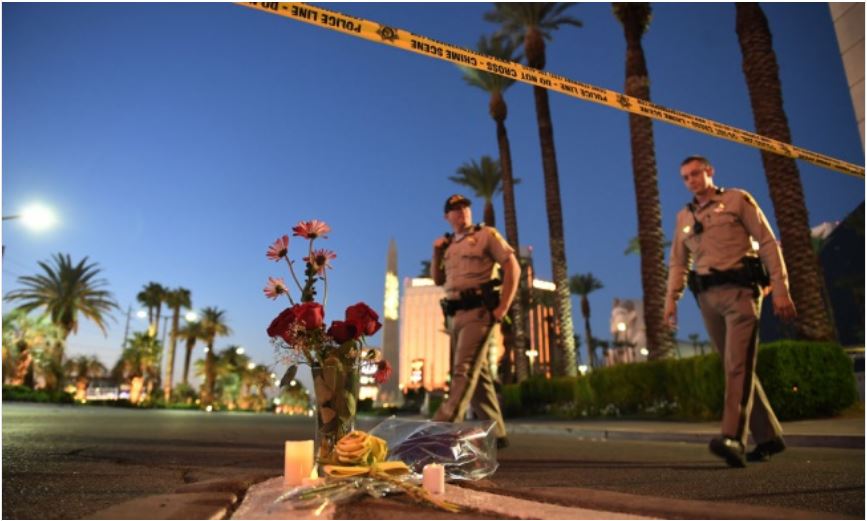by Mike Males
Even before a 64-year-old real estate investor shot and killed 58 people in Las Vegas on Sunday, resulting in the deadliest mass shooting in modern U.S. history, researchers had been slow to acknowledge a disturbing pattern among a once-taboo demographic: middle-aged Whites.
The latest CDC statistics show Whites 35 and older—America’s wealthiest and most politically powerful demographic—make up 37 percent of the population but 47 percent of the nation’s gun deaths and 55 percent of deaths from illicit drugs. White men 35 and older, just 18 percent of Americans, now account for 40 percent of all gun fatalities, and 31 percent of illicit-drug deaths.
These numbers are worsening by the year. Yet, this is a population more likely to have resources, is hardly targeted by police, and has access to higher levels of legal, medical, and psychological care compared to that of younger and non-White Americans.
Tabulations of mass shooters vary in design and completeness, but several that are reviewed consistently show the overwhelming majority of those whose races are identified are non-Latino Whites, and most are over age 35.
In a particularly jarring statistic from California—the only state to tabulate crime by race crossed with age—non-Latino Whites age 40 and older (a record 335,000 in 2016) are now being arrested for criminal offenses at a higher rate than are Blacks and Latinos under age 30 combined.
Unique to the older white demographic is a surge in extreme reactionary views.
This is new, as is the fact that older Whites are California’s only population by age and race showing increased imprisonment rates. Nationally, 60,000 more older Whites are in prison today than in 2000, while younger ages show decreases, according to theBureau of Justice Statistics. These are not statistics one normally associates with a population whose median annual family income approaches $90,000.
Older Whites are also the population in which gun ownership is becoming the most concentrated—along with considerable increases in firearms deaths since 2000—as young people increasingly turn away from guns, the Violence Policy Center reports from surveys. In that respect, Las Vegas shooter Stephen Paddock was a poster figure. Paddock died from a self-inflicted gunshot from one of the 23 guns authorities found in his hotel room; he owned at least 47 firearms by latest count, as well as explosives and thousands of rounds of ammunition.
Also unique to the older White demographic is a surge in extreme reactionary views, concentrated in majority-White rural and suburban areas where they’re suffering the worst casualty rates from guns, drugs, suicide, and other violent means.
The divergence of older Whites from other American populations in a variety of extreme behaviors and attitudes raises the question of whether there is an overarching connection.
Certainly, media as well as political and institutional authorities have not hesitated to stigmatize young, immigrant, and non-White populations—as gangsters, thugs, “deadly demographics,” “monsters next door,” and just plain “bad people”—based on the actions of a disproportionate few. Because of this double standard, we are not likely to see authorities rushing to demonize the entire older White demographic.
The longer-term irony is that, yet again, Republicans in Congress will likely reject calls for even modest gun controls, such as background checks for gun purchasers. While these controls have not been shown to reduce murders or mass shootings, they are strongly linked to fewer gun suicides, exactly the tragedy most afflicting older Whites, who are Republicans’ largest constituency.
The bottom line is older White people own guns—lots of them.
The bottom line is older White people own guns—lots of them. And they disproportionately use them to kill, mostly themselves in suicides but also in rarer but extremely deadly mass shootings with dozens or even hundreds of casualties. Aging Whites’ disturbed reactions along a continuum of drugs, suicide, guns, the politics of rage, and mass violence have been building for decades—and have been just as steadfastly ignored by leaders often seeking to exploit them.
America’s political leaders have too long insisted on blaming social problems on younger, poorer, and non-White populations. They offer punitive solutions founded in stigmas and exclusion to change those groups’ behaviors, then are baffled when confronted with crises centered in privileged constituencies. Drugs and gun violence are no longer problems of stupid kids downtown and stupid White kids imitating them, as once thought. Las Vegas is just the latest price for years of self-serving bigotries—a price getting steeper by the day. Alarm at the carnage of mass shootings is justified. Hopelessness is not.
But solutions to America’s gun carnage are not likely to come from Washington lawmakers, unwilling to give up old clichés and entrenched racism. While leaders endlessly quarrel over guns amid racialized, age-based fears and stereotypes, it’s the young, diverse populations in big cities once thought uniquely at risk for shootings that are already disproving racist, anti-immigrant, anti-youth rhetoric.
As I noted in the American Journal of Public Health, in recent decades gun death rates have been falling fastest in the nation’s three most populous states with very different gun laws—New York, California, and Texas— and seven times faster than the rest of the country. All three states’ declines were led by 70 to 90 percent reductions in gun killings over the last 25 years among urban teenagers and young adults ages 15–24 in racially diverse, immigrant-influenced large cities like Los Angeles, New York City, Dallas-Fort Worth, San Antonio, and San Diego.
These dramatic, unexpected trends offer a way out of the currently ossified gun debate, if anyone’s paying attention.

